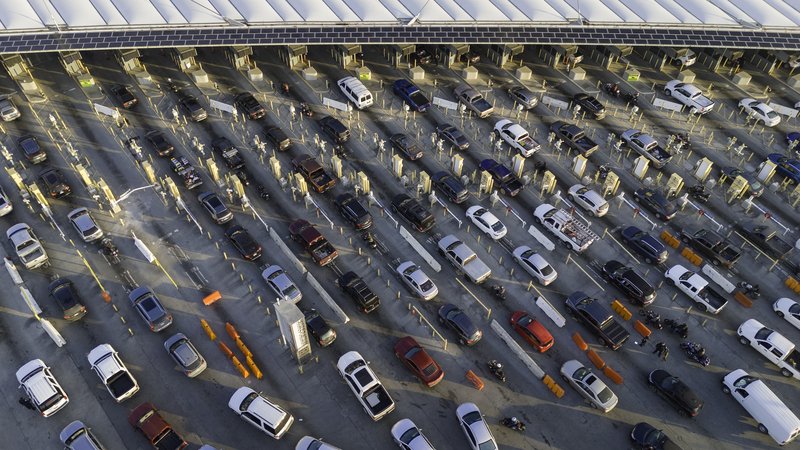Business
Rhetoric vs. Reality: Debunking Popular Myths Surrounding Immigration

Morning commuter traffic waits to cross into the United States from Tijuana, Mexico, in March. South of San Diego, the San Ysidro Port of Entry is the largest land crossing between the two countries and the most transited in the Western Hemisphere. Approximately 70,000 vehicles and 20,000 pedestrians cross daily. Border and immigration issues dominate the 2024 presidential election discourse. Photo by John Moore | Getty Images
MYTH: Immigrants increase crime rates.
A long-standing argument against immigration claims that migrants contribute to higher crime rates in the United States. This misconception gained traction during electoral campaigns, notably with former President Donald Trump’s assertion in 2016 that Mexico sends its “worst” people. Similarly, Republican vice presidential nominee J.D. Vance linked immigrant communities to crime during a police association meeting earlier this year.
However, evidence contradicts this narrative. Numerous studies indicate that immigrants are less likely to engage in criminal activity compared to U.S.-born citizens. An analysis covering 150 years reveals that U.S.-born individuals have consistently exhibited higher incarceration rates than their immigrant counterparts, with immigrants today being 60% less likely to be incarcerated, as noted by the National Bureau of Economic Research.
Moreover, crime rates, including violent crime, have decreased in many U.S. cities since their pandemic highs. Contradicting claims made by some politicians, factual data shows that crime levels in border cities are often lower than the national average.
For Irayda Flores, a Phoenix businesswoman who emigrated from Sonora, Mexico, the portrayal of immigrants as criminals is frustrating. Since 2004, she has built a successful seafood wholesale business, El Mar de Cortez Corp, which serves local restaurants and employs several people. She criticized the political narrative that overlooks the positive contributions of immigrants, asserting, “They leave their home countries in search of opportunity, not to engage in crime.”
Dismissing migrants uniformly as criminals is misleading, she argues, noting that many have positively influenced their communities and the economy. “Generalizing immigrant identities is harmful,” Flores added. “They deserve respect for their contributions.”
MYTH: There’s an invasion at the U.S.-Mexico border.
As the election season intensifies, some politicians are promoting an “invasion” narrative concerning border issues. Recent data shows a significant surge in migrant encounters at the U.S.-Mexico border. December 2023 recorded over 300,000 encounters, but that number drastically fell to about 176,000 by January 2024, reaching a three-year low later that summer.
MYTH: Fentanyl is smuggled primarily by migrants.
The U.S.-Mexico border is approximately 2,000 miles long and involves 26 land ports of entry. However, the U.S. Department of Homeland Security reports that the majority of fentanyl is smuggled into the U.S. by citizens using legal routes. Over 90% of confiscated fentanyl at the border was seized at legal ports, and cartels frequently employ U.S. citizens to facilitate trafficking.
MYTH: Immigrants exploit public benefits.
Most non-citizen immigrants are ineligible for public benefits. Federal assistance programs such as Section 8 housing and SNAP are strictly for U.S. citizens. However, legal permanent residents may access some benefits after five years. Emergency Medicaid and specific programs, like WIC, provide essential care in urgent situations. Access to state-level benefits varies significantly across the country.
MYTH: Gaining U.S. citizenship is simple.
The path to U.S. citizenship is arduous and costly, often involving extensive paperwork and fees. Many hopeful migrants encounter long wait times due to backlogs in naturalization and asylum processes. For those seeking residency through marriage, authorities implement rigorous verification procedures. Deferred Action for Childhood Arrivals (DACA) offers temporary protection for some undocumented individuals, yet it is not a pathway to permanent residency, and its future remains uncertain due to ongoing legal challenges.
MYTH: Immigrants don’t pay taxes.
Estimates suggest that around 11 million undocumented immigrants contribute significantly to the U.S. economy, paying approximately $383 billion in federal taxes and $196 billion in state and local taxes. Unlike the widespread belief that they exploit tax systems, undocumented immigrants generate revenue without benefiting from programs like Social Security.
Saúl Rascón, a DACA recipient and pro-immigrant advocate, expressed frustration with the stereotype that immigrants do not contribute economically. He highlighted the detrimental impact of misinformation, which fosters hostility towards immigrant communities and complicates efforts to reform immigration policies. “We need to shift focus back to the contributions of Dreamers and undocumented individuals,” Rascón emphasized.
This discourse surrounding immigration sheds light on the complexities and nuances involved, countering prevailing myths while highlighting the vital roles migrants play in American society.


















